Abstract
This is a replication and extension of a study by Man et al. in Journal of Developmental and Physical Disabilities 18:35–44, 2006, who found that college students rated the romantic attractiveness of opposite-sex peers as equal, regardless of the presence or absence of a physical disability. Based on photographs with brief biographical vignettes 41 college students rated attractiveness of young adults with the Romantic Attraction Scale (RAS; Campbell in Journal of Personality and Social Psychology 77:1254–1270, 1999) and then completed the Implicit Association Test (IAT; Nosek et al. in Personality and Social Psychology Bulletin 31:166–180, 2005) to assess their implicit attitudes toward disabilities. Self-reported romantic attractiveness was unaffected by the presence of a physical disability. However, the IAT revealed a clear preference for physical health over physical disabilities. The discrepancy between the explicit attractiveness ratings and the implicit attitudes toward physical disabilities suggests that the former were biased by social desirability. Alternative explanations of the inconsistencies between the explicit and implicit data are discussed.

Similar content being viewed by others

Notes
Terms used by the IAT.
References
Campbell, W. (1999). Narcissism and romantic attraction. Journal of Personality and Social Psychology, 77, 1254–1270.
Crown, D. P., & Marlowe, D. (1960). A new scale of social desirability independent of psychopathology. Journal of Consulting Psychology, 24, 349–354.
Gawronski, B., LeBel, E. P., & Peters, K. R. (2007). What do implicit measures tell us? Perspectives in Psychological Science, 2, 181–193.
Gething, L., & Wheeler, B. (1992). The Interaction with Disabled Persons Scale: A new instrument to measure attitudes towards people with disabilities. Australian Journal of Psychology, 9, 23–42.
Greenwald, A., McGhee, D., & Schwartz, J. (1998). Measuring individual differences in implicit cognition: the Implicit Association Test. Journal of Personality and Social Psychology, 74, 1464–1480.
Hergenrather, K., & Rhodes, S. (2007). Exploring undergraduate student attitudes toward persons with disabilities: Application of the disability social relationship scale. Rehabilitation Counseling Bulletin, 50, 66–75.
Louvet, E. (2007). Social judgment toward job applicants with disabilities: Perception of personal qualities and competences. Rehabilitation Psychology, 52, 297–303.
Man, M., Rojahn, J., Chrosniak, L., & Sanford, J. (2006). College students’ romantic attraction toward peers with physical disabilities. Journal of Developmental and Physical Disabilities, 18, 35–44.
Nosek, B. A., Greenwald, A. G., & Banaji, M. R. (2005). Understanding and using the implicit association test: II. Method variables and construct validity. Personality and Social Psychology Bulletin, 31, 166–180.
Paulhus, D. L. (1984). Two component models of social desirable responding. Journal of Personality and Social Psychology, 46, 598–609.
Petty, R. E., Facio, R. H., & Briñol, P. (Eds.). (2008). Attitudes: Insights from the new implicit measures. Mahwah, NJ: Erlbaum.
Susman, J. (1994). Disability, stigma, and deviance. Social Science Medical, 38, 15–22.
Wilson, T. D., & Dunn, E. W. (2004). Self-knowledge: Its limits, value and potential for improvement. Annual Review of Psychology, 55, 493–518.
Yazbeck, M., McVilly, K., & Parmenter, T. (2004). Attitudes toward people with intellectual disabilities: an Australian perspective. Journal of Disability Policy Studies, 15, 97–122.
Author information
Authors and Affiliations
Corresponding author
Rights and permissions
About this article
Cite this article
Rojahn, J., Komelasky, K.G. & Man, M. Implicit Attitudes and Explicit Ratings of Romantic Attraction of College Students Toward Opposite-Sex Peers with Physical Disabilities. J Dev Phys Disabil 20, 389–397 (2008). https://doi.org/10.1007/s10882-008-9108-6
Received:
Accepted:
Published:
Issue Date:
DOI: https://doi.org/10.1007/s10882-008-9108-6



